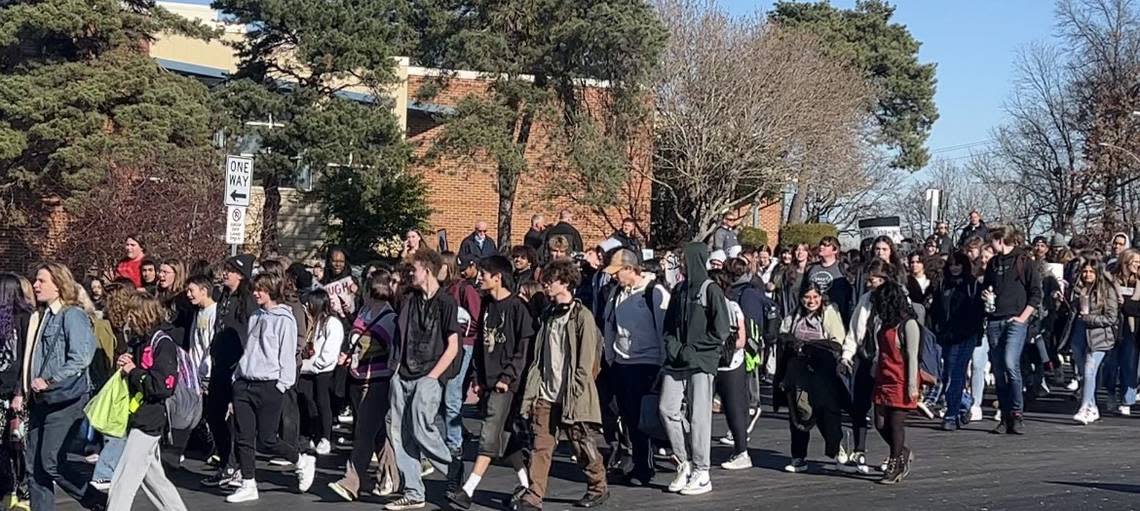Shawnee Mission answers students’ pleas after racist attack, adds punishment for slurs

Reality Check is a Star series holding those with power to account and shining a light on their decisions. Have a suggestion for a future story? Email our journalists at RealityCheck@kcstar.com.
The Shawnee Mission school board has updated its student code of conduct to specifically name the use of slurs as a punishable offense, a move that students pleaded for following a racist attack on a Black student late last year.
The school board at its most recent meeting last month voted 7-0 to update the student handbook, changes that also included spelling out specific discipline for discrimination and harassment. Christy Ziegler, the district’s chief of student services, said the update stems from focus groups and roundtable discussions with students over the winter.
Students began protesting last November, pleading for district officials to take action after a Black, female Shawnee Mission East student was sent to the hospital when she was beat up by a white, male student shouting the N-word. The altercation — which resulted in the white 15-year-old being charged with a felony — shook the Johnson County community, but did not come as a surprise to many who said racism runs rampant at the predominantly white school.
Several students previously told The Star that they’ve witnessed a pattern of racist incidents at the school, including students using slurs toward other students, which they said the school has not taken seriously enough. Among their demands, students urged the district to issue harsher punishments for hate speech and racial discrimination.
Student voices heard
Shawnee Mission’s former student code of conduct did not specifically list the use of racial slurs or hate speech as an offense, The Star previously reported.
District spokeswoman Kristin Babcock previously said such behavior would still be punished, but it would fall under different categories in the code of conduct depending on the context. The use of a racial slur could potentially have fallen under the offense of use of profane or obscene language, for example.
The district also has had standard policies prohibiting any discrimination or harassment, including racial discrimination or bullying among students, plus barring the “use of profanity, personally insulting remarks, attacks on a person’s race, gender, nationality, religion, or behavior that disrupts learning or the safety of anyone in the environment.”
But some argued that left discipline for discriminatory behavior up to administrators’ discretion, saying that didn’t go far enough to ensure student safety. They argued the code of conduct should have more specific punishments spelled out for schools to follow.
During the school board meeting, Ziegler emphasized that administrators “have been reacting and being responsive, addressing behaviors and providing consequences” despite not having the specific language in the code of conduct.
But after meeting with students across the district, she said, “We determined we need to be more specific and explicit in addressing communication that pertains to significant disrespect, specifically as it relates to jokes that may be shared, jokes that may include slurs or other derogatory or demeaning comments.
“That was the voice our students brought to us.”
The updated code of conduct now includes categories reflecting those non-discrimination policies, with specific punishments for such verbal attacks, or discrimination and harassment other than sexual harassment, which is a separate item.
Under the updated handbook, punishment for the use of a racial slur ranges from an office referral, detention or apology for first-time offenses, up to a short-term, out-of-school suspension or expulsion for more serious, repeated offenses. Student behavior that falls under the new category for discrimination or harassment could be punished with removal from class or short-term suspension, up to expulsion.
“This additional language provides explicit recognition and an opportunity to address and communicate and educate as our students and families come back to us in the fall on what is appropriate versus what is inappropriate in our schools,” Ziegler told the board.
Shawnee Mission East protests
Students began pushing for the change as they felt the racist attack at East in November was a boiling point in the school where many said racist bullying is too common and often goes unchecked.
A video shared with The Star showed the 15-year-old Black, female student confronting classmates about their use of racist language, suggesting the students were referring to Black people as “slaves.”
She walks away while saying, “Don’t say nothing unless you’re gonna come say it to my face.” Then a white, male student told her to, “Shut the **** up.” The female student turns around and starts walking in his direction. He charges toward her, shouting the N-word. He then pushes her, and she throws a punch. They both start swinging until the fight is broken up. Students said the girl went to the hospital with a broken nose.
Dozens of students walked out of class days later.
The boy was charged with felony aggravated battery in Johnson County District Court as a juvenile. In May, the teenager pleaded guilty to a single felony of aggravated battery. He was sentenced to 18 months in juvenile detention to be followed by 12 months of state-supervised after care.
Court records show he also was charged with felony aggravated battery and aggravated assault, as well as misdemeanor battery, in a separate June 2023 case. The unrelated domestic felony case was dismissed, according to court documents.
In Olathe, following protests last year — sparked by white students using a racial slur against a Black classmate — the school board voted to make racial harassment and hate speech a more serious offense under its student code of conduct.
The Star’s Bill Lukitsch contributed reporting.






